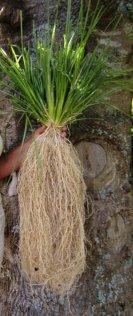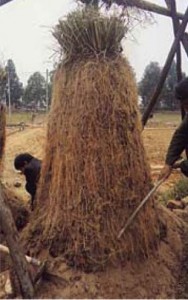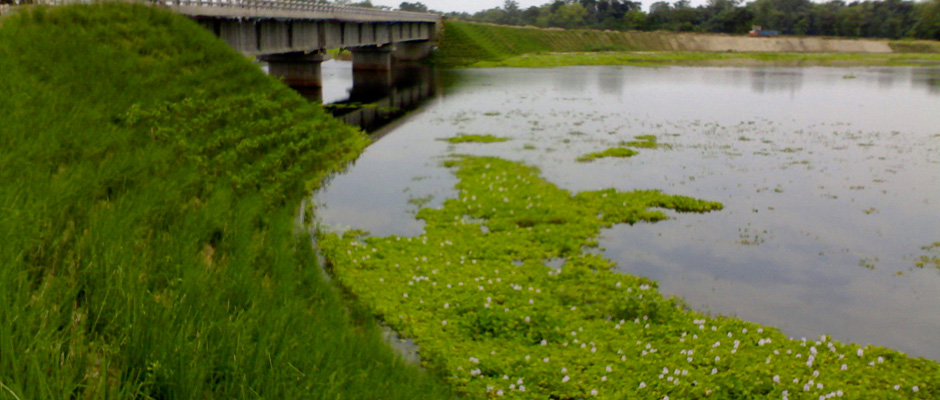Erosion Control
Ve tiver offers solutions to erosion due to flooding, slips and poor drainage. It works in virtually any soil type including clay, rock and sand. tiver offers solutions to erosion due to flooding, slips and poor drainage. It works in virtually any soil type including clay, rock and sand.
It had been used for centuries in India, for decades around the world and with thousands of successful plantings over the last 22 years in New Zealand. Government, agricultural and scientific studies show Vetiver to be 100% effective. We know that the “VETIVER SYSTEM” stops erosion.
Vetiver can stop both types of erosion - Surface erosion and ground movement
How it works
-
The ground is locked in by the complex, deep, strong, fibrous root system. When correctly planted as a hedge these roots bind with the earth and form an interlocked, incredibly strong underground wall preventing ground movement.
-
The above ground Vetiver hedge slows or stops surface runoff. The hedge traps particles,spreads excess water along the hedge and the large roots and dense foliage allow controlled drainage.
Vetiver roots at 4 months growth
The Root Cause
Vetiver sends its roots straight down not out like other grasses. Vetiver roots can penetrate to 2 metres in the first year. They will later penetrate 4 to 6 metres in virtually any soil. Above ground the plant can grow to 1.2 metres high and 700mm wide and with the roots below ground also about 700mm wide.Correctly installed, Vetiver’s deep roots mean you do not need to irrigate this plant.

What is the difference between other erosion control plants and the "Vetiver System"?
Virtually no other plant has this type of root system. Vetiver has a large, dense, strong root system to 5 metres deep. Rather than placing plants randomly, Vetiver is grown as a hedge directly across the slope at the rate of 5 plants per metre. This allows the roots to interlink correctly under the ground . With a relatively small top, Vetiver can fit into a wide variety of situations. Vetiver can live over 200 years so is considered a permanent solution.
A simple demostration of root strength is available when two or three strands of established root material is combined, manually trying to break them is extremely difficult.
Virtually maintenance free. Vetiver offers a fast, natural, permanent solution to protecting your property. A low cost solution when compared to alternatives.
Perfect for erosion
Vetiver stops erosion with a hedge just one plant wide.
Vetiver is non-invasive – it will not turn into a weed.
Vetiver is drought and frost tolerant.
Vetiver requires low maintenance.
Vetiver can survive floods, windstorms, fire, grazing animals and other forces of nature.
Vetiver is a very tough and hardy plant.
Vetiver does not compete seriously with neighbouring crop plants for moisture or nutrients.
Vetiver can grow in many soil types including sand, gravels, and clay.
Acidity, alkalinity, salinity and most contaminated soils are tolerated.
Vetiver grass is climate change compatible.Vetiver can adapt to temperatures from 10 to 50 degrees celcius.
Vetiver has no known pests or diseases.
Vetiver controls weeds (when blanket planted).
Vetiver lives for 200 + years.
Vetiver does not mind lengthy submergence and is suitable for the edges of dams, ponds, rivers and bridge abutments.
Generally Vetiver will grow throughout temperate New Zealand from about Nelson northwards.
Vetiver is climate change compatible. Vetiver can adapt to temperatures from 10 to 50 degrees celcius.
And apart from all of the above Vetiver grass also makes a fast, attractive, tropical looking low maintenance hedge.
The "Vetiver System"
It is easy to install a "Vetiver System". For erosion purposes Vetiver is planted in rows directly across the slope at the tried and proven 5 plants per metre or one plant every 20cm. I find that when customers go to plant they may feel this spacing is too close but be assured this is correct. As a grass it does not mind being close. It is important the roots interlink at the correct rate under ground. The base of the above ground hedge will form a gapless wall so it can spread surface water and allow it to flow up and through the "system", filtering sediment but also taking the power out of surface water, the large roots allowing controlled drainage.
Often one row, usually near the top of a slope is all that is required. Larger slopes or high risk zones often require more rows. Some customers opting to plant the entire area with rows 1 metre apart. This allows maximum erosion protection. In this case the Vetiver forms a low canopy blocking out the light and reducing maintenance. Visually blanket planting is a nice even, lush, tropical look. Interplanting with slim, upright trees or palms can give a nice resort style landscape.
Vetiver grass grows well in most areas north of Nelson including all of the North Island. It is not vital but Vetiver grows at its best when trimmed to 500 mm high once every year (or three) in the spring. This small amount of upkeep is all that is required to maintain a very healthy system. A sprinkle of bood and bone fertilizer is also recommended.
Vetiver is ideal for:
-
Dam, pond, stream or river sidings
-
Infrastructure such as roads,railways,bridge abutments
-
Building sites
-
Exposed earth worked areas
-
Agricultural erosion control
-
Hills and cliffs
Particle Catchment
The hardy, tough, 600 to 900mm wide base of a Vetiver hedge is very good at trapping particles. Vetiver does not mind if silts and soils are built up behind it. Vetiver adjusts naturally. In extreme cases vetiver can build a 2 metre high wall behind it, forming a terrace.
Around New Zealand and especially here in Northland our rivers, harbours and inlets are filling up with silt, soils and agricultural runoff. A row of this grass across critical watersheds would reduce or stop silt build-up down stream. Large plantings would be required but it may be that the expense would be far outweighed by the financial and environmental benefits from saving our precious waterways.

Retaining Walls
Retaining walls made of treated wood (as most are in New Zealand) are very expensive and are full of contaminants. They may only last 25 years!
In many applications, Vetiver can provide a much better solution. If you have to use a retaining wall, back-planting with Vetiver will strengthen the installation and may reduce the amount of engineering required. When your retaining wall finally needs replacement vetiver will have been long established and will have bound your wall tight, all the time removing the heavy metals and toxins left by the wood treatment. At the same time the Vetiver hedge stops surface runoff and the roots draw moisture away from the wall.
Plant requirements
Vetiver requires sun. Preferably direct sun. At least 4 hours per day ( if the sun was out all day). Vetiver may die in full shade.
Vetiver will grow in most areas of New Zealand north of Nelson/Blenheim including all of the North Island.
Vetiver will grow in a wide range of conditions from nothing but sand through to nothing but water.
Usually you can simply plant and walk away. If conditions are dry some establishment irrigation may be required (especially for the smaller bio bag plants)
Please click the planting tab to see the planting instructions.
Vetiver requires little maintenance but it is recommended that your "Vetiver System" receives a trim to knee height and a sprinkle of blood and bone fertiliser every spring (avoid trimming in the winter) Trimmings can be delayed up to three years.
Bio security
Vetiver installations for erosion are a three part story. First you must have the correct plant. Second it must be planted with the correct system. Third the system must be applied to your situation. Simple to install but getting the basics correct is important. Sometimes Vetiver is tasked with heavy lifting in critical locations. Contacting us is a great way to start.
Bio security
Our enclosed purpose made facility not only grows bigger stronger plants it is also bio secure. We know you do not want new weeds and/or diseases. Beware of the cowboys growing Vetiver plants outdoors.
Vetiver is naturally a strerile clone with zero weed potential.
Certified Stock Vetiver plants grow easily. They are very determined to work hard for you. It is normal to expect no losses.
Ordering plants
To calculate how many plants are required simply measure or step out your total planting meterage and times by five.
Email or phone your order through. That's it. Easy !
We prefer to grow your plants to order. Vetiver roots grow quickly. It is important that your plants are delivered at the correct stage. There is 48 very manual steps involved in producing a plant from start to delivery and because the plants can root bind quickly it is important to us not to waste plants.Typically plants are ordered in the winter and delivered in the spring. We do also have plants available throughout spring and summer.
No deposit is required
Delivery timing is dependant on nature and you. We work with nature and deliver when it is convienient for you.
We will be intouch with planting instructions 1 month ahead of delivery so that you have time to do any preperation and of course pay the invoice.
Normally we prepare three lots of plants through the planting season. 1) October/November 2)January 3)March
Freight is at cost and packaging is free.
It is good to know how we package plants so that you can receive maximum value from the freight. We either dispatch on pallets or banana boxes.
Maximum amount of bio bag plants in a banana box is 50. Maximum Pb5 plants on a pallet is140.
Click
Here for the Vetiver International Website.www.vetiver.org/
for all the information you will ever need.

|
